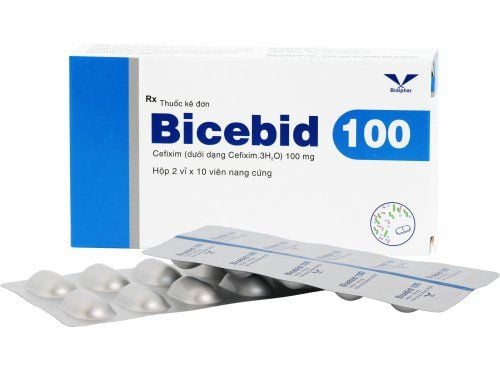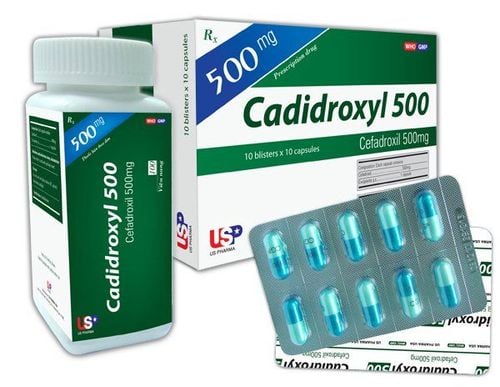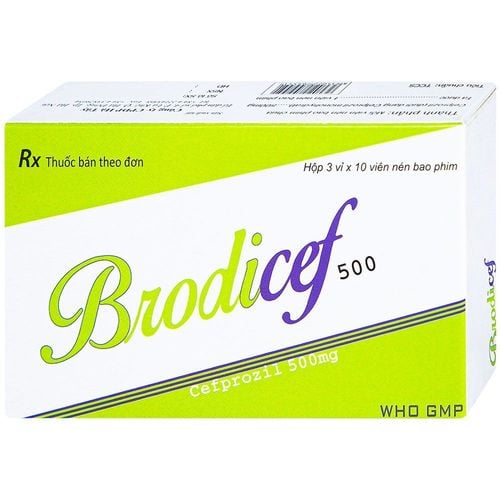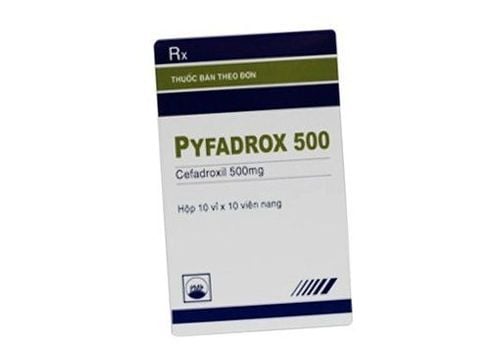This is an automatically translated article.
Dodacin has the main ingredient is Sultamicillin, content of 375 mg, belongs to the group of antibiotics commonly used in the treatment of bacterial infections in the respiratory tract, urinary tract and skin tissue... Learn the conceptual information An overview of the ingredients, uses, doses and side effects of Dodacin will help patients or their families improve treatment results.
1. What is Dodacin?
Dodacin drug is prepared under film-coated tablets, with the main ingredients including:
Active ingredient: Sultamicillin (as Sultamicillin tosilate) content 375 mg. Excipients: Croscarmellose sodium, Magnesium stearate, Avicel pH 112, Eudragit E100, Polyethylene glycol 6000, Aerosil, Talc powder, Titanium dioxide just enough for 1 film-coated tablet. Sultamicillin is a double ester consisting of the Beta Lactamase inhibitor Sulbactam and Ampicillin attached to the methylene group. After being absorbed in the gastrointestinal tract, the active ingredient Sultamicillin will hydrolyze to give Ampicillin and Sulbactam with a molecular ratio of 1:1 and enter the circulatory system. Ampicillin is an antibiotic belonging to the Beta Lactam group that inhibits the biosynthesis of mucopeptides of bacterial cell walls, thereby having the ability to kill bacteria.
The antibacterial spectrum of Ampicillin is quite broad, including both Gram-positive and Gram-negative bacteria such as: Staphylococcus epidermidis (including penicillin-resistant bacteria or some Methicillin-resistant bacteria, Staphylococcus aureus, Streptococcus faecalis, Streptococcus pneumoniae) and one other strains of Streptococcus. Parainfluenzae includes both Beta Lactamase-producing and non-Beta Lactamase-producing strains, Haemophilus influenzae, Branhamella catarrhalis. Anaerobic bacteria include Bacteroides fragilis, Escherichia coli, Klebsiella. Citrobacter, Enterobacter, Morganella morganii, Neisseria gonorrhoeae and Neisseria meningitidis. Sulbactam is an antibiotic with a mechanism of irreversible inactivation of important Beta Lactamase enzymes of penicillin-resistant strains of bacteria. The antibacterial spectrum of Sulbactam is quite narrow and includes: Acinetobacter calcoaceticus, Neisseriaceae, Bacteroides spp, Pseudomonas cepacia and Branhamella catarrhalis.
Currently, the use of a combination of Ampicillin and Sulbactam shows a more pronounced effect than using a single antibiotic. The reason is that Sulbactam has the ability to protect penicillin or cephalosporin drugs from being destroyed by beta lactamase-secreting bacteria, and has a clear synergistic effect with penicillin or cephalosporin drugs.
2. What does Dodacin do?
Dodacin is indicated for treatment in the following cases:
Infections in the upper respiratory tract such as: Sinusitis, tonsillitis, otitis media and epiglottitis. Bacterial infections in the lower respiratory tract such as: tracheobronchitis, pneumonia. Urinary tract infections such as: pyelonephritis, pyelonephritis and urinary tract infections. Skin or soft tissue infections. Sepsis. Gonorrhea .
3. Contraindications of Dodacin
Hypersensitivity to any ingredient in Dodacin. History of allergy to other medicines containing Ampicillin or Sulbactam. History of allergy to other antibiotics of the Beta Lactam group.
4. Dodacin dosage and usage:
Adults and children ≥ 30 kg:
Dose: Take 1-2 tablets/time x 2 times/day. Continue treatment for 2 more days after symptom relief. Duration of treatment is 5-14 days. Children < 30 kg
Dose: Take 25 -50 mg/kg/day x 2 times/day. Duration of treatment is 5-14 days. Gonorrhea:
Dose: Take 6 tablets (2.25 g)/time, use a single dose and combine with 1g of Probenecid. Patients with renal impairment:
Adjust dose based on Creatinine clearance (CrCl):
CrCl dose ≥ 30 ml/min: Take 4 to 8 tablets (1.5 to 3 g) in 6-8 hours. Dose of CrCl 15 - 29 ml/min: Take 4 - 8 tablets (1.5 - 3 g) in 12 hours. Dose of CrCl 5 - 14 ml/min: Take 4 - 8 tablets (1.5 - 3 g) in 24 hours.
5. Notes when using Dodacin
5.1 Side effects encountered when using Dodacin Treatment with Dodacin in high doses or for a long time, can cause side effects such as:
Symptoms of digestive disorders: Nausea, vomiting, abdominal pain, heat epigastric burning, diarrhea or loose stools. Symptoms such as abdominal cramps, colitis or pseudomembranous colitis rarely occur. Hypersensitivity: Skin rash, urticaria, redness, itching, severe cases may cause anaphylaxis. Erythema multiforme, toxic epidermal necrolysis, and Stevens Johnson syndrome occur rarely. Neurological symptoms: Headache, dizziness, dizziness, drowsiness, fatigue. Liver function abnormalities: Transient elevation of liver enzymes, cholestatic jaundice and hyperbilirubinemia. Hematopoietic system abnormalities: Anemia, leukopenia, eosinophilia and thrombocytopenia. When detecting the above side effects or any other abnormality after taking Dodacin, patients and relatives should promptly notify their doctor or pharmacist or go to a medical facility for timely treatment. .
5.2 Notes on the use of Dodacin in subjects Be careful when using Dodacin in the elderly, infected patients with signs of superinfection. People with impaired liver - kidney function and blood-forming organs, need to periodically check blood tests, and liver - kidney function to adjust the dose appropriately. Pregnancy: According to the US Food and Drug Administration (FDA) classification of active ingredients Ampicillin/Sulbactam in group B, there is no evidence of risk. However, it is necessary to weigh the benefits and harms when deciding to use Dodacin in this population. Lactation: Studies suggest that either Ampicillin or Sulbactam in Dodacin can pass into breast milk, but in small amounts. Caution is advised when using Dodacin in lactating women. Drivers or machine operators are less likely to be affected by the use of Dodacin, but should be avoided immediately before and during work.
6. Dodacin drug interactions
Dodacin increases the concentration and duration of action of the drug Sulcilate. Taking the active ingredient Ampicillin with Allopurinol may increase the incidence of rash. Above is basic information about ingredients, uses, doses and precautions when using Dodacin. In order to bring about the best treatment effect, patients and their relatives should carefully read the instruction sheet of Dodacin drug, and strictly follow the treatment instructions of the doctor.
Please dial HOTLINE for more information or register for an appointment HERE. Download MyVinmec app to make appointments faster and to manage your bookings easily.













